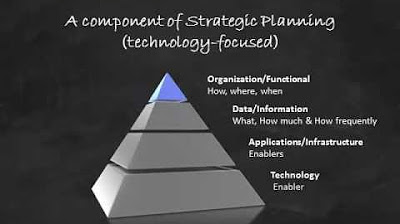Mark Van Bavel : Global Merger with Digital Transformation using Enterprise Architecture as Strategy
Summary
TLDRIn this presentation, the speaker outlines the journey of using enterprise architecture as a strategic framework for transformation and digitization within an organization. Emphasizing the importance of aligning business capabilities with technology, they discuss mapping current and future states, employing data-driven decision-making, and engaging business partners. The speaker highlights the need to decouple architectural layers to enhance flexibility and reduce dependencies, ultimately leading to a clear target operating model. By framing the transformation process around a shared capability model, they aim to foster ownership and drive successful outcomes in a rapidly changing business environment.
Takeaways
- 😀 Aligning business strategy with technology is essential for successful transformation.
- 📈 A capability model helps identify gaps between current and desired states, guiding strategic improvements.
- 🔄 Decoupling architectural layers allows for greater flexibility and reduces dependencies in system changes.
- 💬 Using business-centric language when discussing technology fosters better communication with stakeholders.
- 📊 Data-driven decision-making is crucial for effective portfolio management and conflict resolution.
- 🤝 Continuous engagement with business partners ensures their needs are reflected in the architectural design.
- 🗺️ A clear target operating model facilitates execution, change management, and prioritization of initiatives.
- 🔍 Measuring performance through KPIs is vital for assessing the effectiveness of strategies.
- 🌍 The transformation journey involves multiple platforms, systems of records, and digital infrastructure.
- 📅 Having a stable framework that links business and technology is key to navigating rapid changes in the business environment.
Q & A
What is the main focus of the presented enterprise architecture (EA) strategy?
-The main focus is to leverage enterprise architecture as a strategic tool for transformation and digitization, aligning business capabilities with technology.
How does the capability model from TSIA help the organization?
-The capability model from TSIA provides a benchmark to assess the organization's current capabilities against industry standards, allowing the organization to identify areas for improvement.
What role do heat maps play in the organization's strategy?
-Heat maps visually represent the current state (as-is) and desired future state (to-be) of capabilities, facilitating clear communication of priorities and initiatives needed to close capability gaps.
Why is decoupling architecture layers important?
-Decoupling architecture layers allows for greater flexibility and reduces dependencies, enabling the organization to implement changes more rapidly and efficiently across different systems.
What is the significance of aligning business strategies with technology?
-Aligning business strategies with technology is crucial because the business environment typically changes faster than the technology landscape, requiring a stable framework to adapt to these changes.
What steps did the organization take after building their strategy?
-After building their strategy, the organization developed a business model, operating model, and capability model, which informed their enterprise architecture and execution roadmap.
How does data-driven decision-making enhance strategy execution?
-Data-driven decision-making enhances strategy execution by providing insights through data collection and analysis, which helps to resolve disputes and guide prioritization in business initiatives.
What is the importance of continuous engagement with business partners?
-Continuous engagement with business partners is essential for ensuring that their needs and interests are reflected in the architecture, fostering buy-in and collaboration throughout the transformation process.
How does the organization manage complexity in its transformation efforts?
-The organization manages complexity by carefully decoupling architectural layers, minimizing dependencies, and ensuring that delays in one area do not adversely impact other initiatives.
What is the value of having a clear target operating model?
-A clear target operating model provides clarity in execution and prioritization, facilitating effective change management during the transformation journey.
Outlines

هذا القسم متوفر فقط للمشتركين. يرجى الترقية للوصول إلى هذه الميزة.
قم بالترقية الآنMindmap

هذا القسم متوفر فقط للمشتركين. يرجى الترقية للوصول إلى هذه الميزة.
قم بالترقية الآنKeywords

هذا القسم متوفر فقط للمشتركين. يرجى الترقية للوصول إلى هذه الميزة.
قم بالترقية الآنHighlights

هذا القسم متوفر فقط للمشتركين. يرجى الترقية للوصول إلى هذه الميزة.
قم بالترقية الآنTranscripts

هذا القسم متوفر فقط للمشتركين. يرجى الترقية للوصول إلى هذه الميزة.
قم بالترقية الآنتصفح المزيد من مقاطع الفيديو ذات الصلة

Lesson 172 - TOGAF in 10 Minutes

An introduction to the concepts of Enterprise Architecture

Lesson 156 - Zachman Framework in 10 Minutes

The Role of Capabilities in IT / Business Strategy Alignment

Arsitektur Enterprise Materi 1 - Introduction = IT Masterplan, Enterprise Architecture and, TOGAF

Digital Transformation Principles
5.0 / 5 (0 votes)
